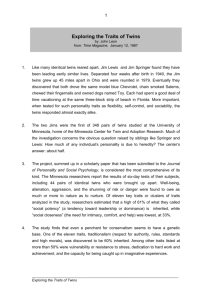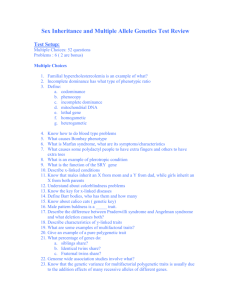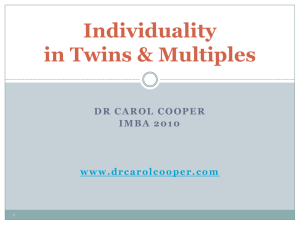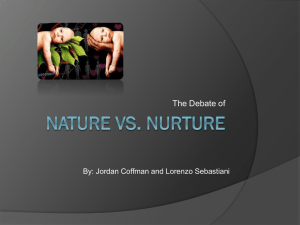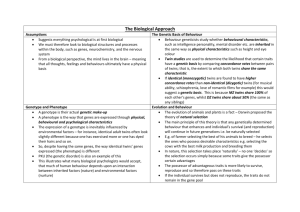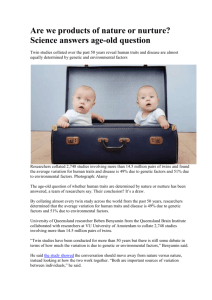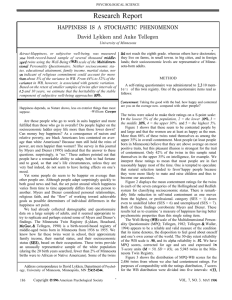Exploring the Traits of Twins
advertisement
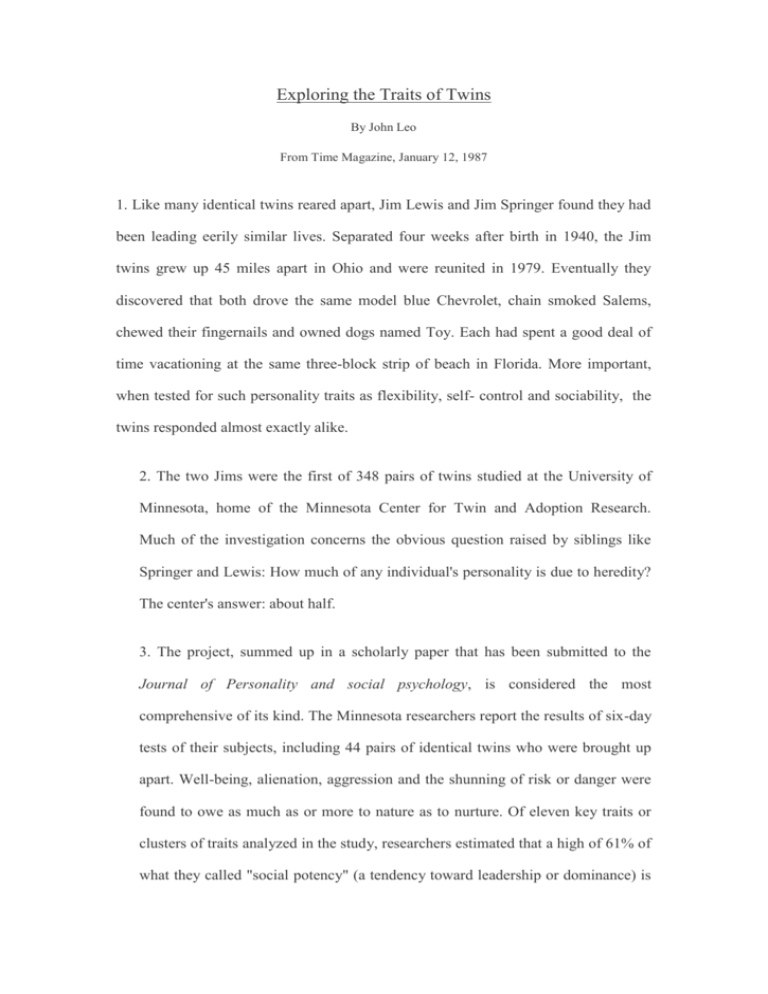
Exploring the Traits of Twins By John Leo From Time Magazine, January 12, 1987 1. Like many identical twins reared apart, Jim Lewis and Jim Springer found they had been leading eerily similar lives. Separated four weeks after birth in 1940, the Jim twins grew up 45 miles apart in Ohio and were reunited in 1979. Eventually they discovered that both drove the same model blue Chevrolet, chain smoked Salems, chewed their fingernails and owned dogs named Toy. Each had spent a good deal of time vacationing at the same three-block strip of beach in Florida. More important, when tested for such personality traits as flexibility, self- control and sociability, the twins responded almost exactly alike. 2. The two Jims were the first of 348 pairs of twins studied at the University of Minnesota, home of the Minnesota Center for Twin and Adoption Research. Much of the investigation concerns the obvious question raised by siblings like Springer and Lewis: How much of any individual's personality is due to heredity? The center's answer: about half. 3. The project, summed up in a scholarly paper that has been submitted to the Journal of Personality and social psychology, is considered the most comprehensive of its kind. The Minnesota researchers report the results of six-day tests of their subjects, including 44 pairs of identical twins who were brought up apart. Well-being, alienation, aggression and the shunning of risk or danger were found to owe as much as or more to nature as to nurture. Of eleven key traits or clusters of traits analyzed in the study, researchers estimated that a high of 61% of what they called "social potency" (a tendency toward leadership or dominance) is inherited, while "social closeness" (the need for intimacy, comfort and help) was lowest, at 33%. 4. The study finds that even a penchant for conservatism seems to have a genetic base. One of the eleven traits, traditionalism (respect for authority, rules, standards and high morals), was discovered to be 60% inherited. Among other traits listed at more than 50%, were vulnerability or resistance to stress, dedication to hard work and achievement and the capacity for being caught up in imaginative experiences. 5. The director of the study, Thomas Bouchard, cautions that the numbers so far may not be strictly accurate. "In general," he says, "the degree of genetic influence tends to be around 50%." Attributing the 28-point gap between potency and closeness to possible sampling errors, he predicted that "social potency will drop and social closeness will creep up." 6. All the twins took several personality tests, answering more than 15,000 questions on subjects ranging from personal interests and values to phobias, aesthetic judgment and television and reading habits. Twins reared separately also took medical exams and intelligence tests and were queried on life history and stresses. Not all pairs matched up as well as the two Jims. California twins Ann Blandin and Barbara Parker, 40, showed only minor similarities. Said Blandin: "Bouchard said we were the most different set of twins in the study." 7. Psychologist David Lykken, one of the Minnesota researchers, thinks the st udy will shove the pendulum further away from the "radical environmentalism" of those who believe the characters of children are more or less created by their parents and environment. Lykken says Test Pilot Chuck Yeager is daring because he was genetically endowed with a low scale fearlessness, a trait that might have been redirected or tamped down but not eradicated. Says Psychologist Nancy Sega, a member of the project: "Parents can work to make a child less fearful, but they can't make that child brave." 8. Adam Matheny of the Louisville Twin Study, the oldest of U.S. twin study groups, says the "mechanism for change is laid down the moment the child is conceived" and that the genes provide "a rough sketch of life." Some psychologists who stress the influence of genes on behavior often speak as if nurture were a by-product of nature." All of us make our own environment," says Development psychologist Sandra Scarr of the University of Virginia. Lykken makes the same point: "the environment molds your personality, but your genes determine what kind of environment you have, seek and attend to." Since the early 1960's, several twin studies have reported that identical twins raised apart are actually more alike than those raised in the same home. Scarr thinks the reason is that parents faced with identical twins try hard to stress differences between siblings. Says She: "Living with the same family seems to increase intellectual similarity and decrease resemblance in personality." 9. Some scholars, such as Princeton psychologist Leon Kamin, fear that the Minnesota results will be used to blame the poor and downtrodden for their own condition. Political liberals have long believed that crime and poverty are by-products of destructive environments. As a result, they are usually suspicious of biological or genetic explanations for their behavior. "These are very ambiguous data that can be interpreted any way you want to." says Kamin. "I'm not saying that anyone is falsifying facts or anything, just that we really know very, very little." For the Minnesota researchers and their allies, however, their study is just one more proof that parenting has its limits. Says psychologist and Twin researcher David Rowe of the University of Oklahoma:" Parents should be blamed less for the kids who have problems and take credit for kids who turn out well." Questions should be answered in your own words, in English, unless otherwise indicated. Answer the questions below in English. 1. What facts pertaining to the twins were revealed once they were reunited? Answer: __________________________________________________________ ___________________________________________________________________ ___________________________________________________________________ ___________________________________________________________________ ___________________________________________________________________ 2. What thesis might the case of the two Jims support? Answer: __________________________________________________________ ___________________________________________________________________ ___________________________________________________________________ ___________________________________________________________________ Answer the question below in Hebrew. 3. Sum up the results of the research conducted within the framework of the Minnesota project. Answer: __________________________________________________________ ___________________________________________________________________ ___________________________________________________________________ ___________________________________________________________________ ___________________________________________________________________ Answer the questions below in English. 4. What do the findings of the Minnesota project suggest about the human potential for altruism? Answer: __________________________________________________________ ___________________________________________________________________ ___________________________________________________________________ ___________________________________________________________________ 5. Name the pair of identical twins least similar in individual characteristics. _________________________________________________________________ _________________________________________________________________ 6. Characterize the radical environmentalists (paragraph 7). Answer: _________________________________________________________ ___________________________________________________________________ ___________________________________________________________________ ___________________________________________________________________ ___________________________________________________________________ Answer the questions below in English. 7. How, according to the extreme hereditarians - paragraph 8 – does one's personality reflect upon one's environment? Answer: _________________________________________________________ ___________________________________________________________________ ___________________________________________________________________ ___________________________________________________________________ 8. How does the writer explain the fact that some identical twins reared apart resemble each other more than those raised in the same home? Answer: _________________________________________________________ ___________________________________________________________________ ___________________________________________________________________ ___________________________________________________________________ 9. Why would liberals and political radicals oppose the heredity thesis? Answer: _________________________________________________________ ___________________________________________________________________ ___________________________________________________________________ ___________________________________________________________________ ___________________________________________________________________ 10. What does the fact that one is inclined to blame parents for kids who have problems suggest? Answer: _________________________________________________________ ___________________________________________________________________ ___________________________________________________________________ ___________________________________________________________________ ___________________________________________________________________
